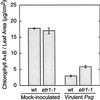Isolation of ethylene-insensitive soybean mutants that are altered in pathogen susceptibility and gene-for-gene disease resistance
- PMID: 10069832
- PMCID: PMC32108
- DOI: 10.1104/pp.119.3.935
Isolation of ethylene-insensitive soybean mutants that are altered in pathogen susceptibility and gene-for-gene disease resistance
Abstract
Plants commonly respond to pathogen infection by increasing ethylene production, but it is not clear if this ethylene does more to promote disease susceptibility or disease resistance. Ethylene production and/or responsiveness can be altered by genetic manipulation. The present study used mutagenesis to identify soybean (Glycine max L. Merr.) lines with reduced sensitivity to ethylene. Two new genetic loci were identified, Etr1 and Etr2. Mutants were compared with isogenic wild-type parents for their response to different soybean pathogens. Plant lines with reduced ethylene sensitivity developed similar or less-severe disease symptoms in response to virulent Pseudomonas syringae pv glycinea and Phytophthora sojae, but some of the mutants developed similar or more-severe symptoms in response to Septoria glycines and Rhizoctonia solani. Gene-for-gene resistance against P. syringae expressing avrRpt2 remained effective, but Rps1-k-mediated resistance against P. sojae races 4 and 7 was disrupted in the strong ethylene-insensitive etr1-1 mutant. Rps1-k-mediated resistance against P. sojae race 1 remained effective, suggesting that the Rps1-k locus may encode more than one gene for disease resistance. Overall, our results suggest that reduced ethylene sensitivity can be beneficial against some pathogens but deleterious to resistance against other pathogens.
Figures




Similar articles
-
New Races of Phytophthora sojae with Rps1-d Virulence.Plant Dis. 1997 Jun;81(6):653-655. doi: 10.1094/PDIS.1997.81.6.653. Plant Dis. 1997. PMID: 30861852
-
Identification of a large cluster of coiled coil-nucleotide binding site--leucine rich repeat-type genes from the Rps1 region containing Phytophthora resistance genes in soybean.Theor Appl Genet. 2005 Jun;111(1):75-86. doi: 10.1007/s00122-005-1993-9. Epub 2005 Apr 20. Theor Appl Genet. 2005. PMID: 15841357
-
The Role of Ethylene Production in Virulence of Pseudomonas syringae pvs. glycinea and phaseolicola.Phytopathology. 2001 May;91(5):511-8. doi: 10.1094/PHYTO.2001.91.5.511. Phytopathology. 2001. PMID: 18943596
-
Races of Phytophthora sojae on Soybean in Illinois.Plant Dis. 2000 Apr;84(4):487. doi: 10.1094/PDIS.2000.84.4.487D. Plant Dis. 2000. PMID: 30841178
-
Over-expression of the Pseudomonas syringae harpin-encoding gene hrpZm confers enhanced tolerance to Phytophthora root and stem rot in transgenic soybean.Transgenic Res. 2018 Jun;27(3):277-288. doi: 10.1007/s11248-018-0071-4. Epub 2018 May 4. Transgenic Res. 2018. PMID: 29728957
Cited by
-
Defence responses regulated by jasmonate and delayed senescence caused by ethylene receptor mutation contribute to the tolerance of petunia to Botrytis cinerea.Mol Plant Pathol. 2013 Jun;14(5):453-69. doi: 10.1111/mpp.12017. Epub 2013 Feb 26. Mol Plant Pathol. 2013. PMID: 23437935 Free PMC article.
-
The salicylic acid-induced protection of non-climacteric unripe pepper fruit against Colletotrichum gloeosporioides is similar to the resistance of ripe fruit.Plant Cell Rep. 2009 Oct;28(10):1573-80. doi: 10.1007/s00299-009-0756-5. Epub 2009 Aug 22. Plant Cell Rep. 2009. PMID: 19701640
-
The evolution of ethylene signaling in plant chemical ecology.J Chem Ecol. 2014 Jul;40(7):700-16. doi: 10.1007/s10886-014-0474-5. Epub 2014 Jul 6. J Chem Ecol. 2014. PMID: 24997626 Review.
-
Ethylene biosynthesis and signaling networks.Plant Cell. 2002;14 Suppl(Suppl):S131-51. doi: 10.1105/tpc.001768. Plant Cell. 2002. PMID: 12045274 Free PMC article. Review. No abstract available.
-
Phytohormones mediate volatile emissions during the interaction of compatible and incompatible pathogens: the role of ethylene in Pseudomonas syringae infected tobacco.J Chem Ecol. 2005 Mar;31(3):439-59. doi: 10.1007/s10886-005-2018-5. J Chem Ecol. 2005. PMID: 15898494
References
-
- Abeles GB, Morgan PW, Saltveit ME. Ethylene in Plant Biology. San Diego, CA: Academic Press; 1992.
-
- Agrios GN. Plant Pathology. San Diego, CA: Academic Press; 1997.
-
- Ben-David A, Bashan Y, Okon Y. Ethylene production in pepper (Capsicum annuum) leaves infected with Xanthomonas campestris pv. vesicatoria. Physiol Mol Plant Pathol. 1986;29:305–316.
-
- Bent A, Innes R, Ecker J, Staskawicz B. Disease development in ethylene-insensitive Arabidopsis thaliana infected with virulent and avirulent Pseudomonas and Xanthomonas pathogens. Mol Plant Microbe Interact. 1992;5:372–378. - PubMed
LinkOut - more resources
Full Text Sources
Other Literature Sources

